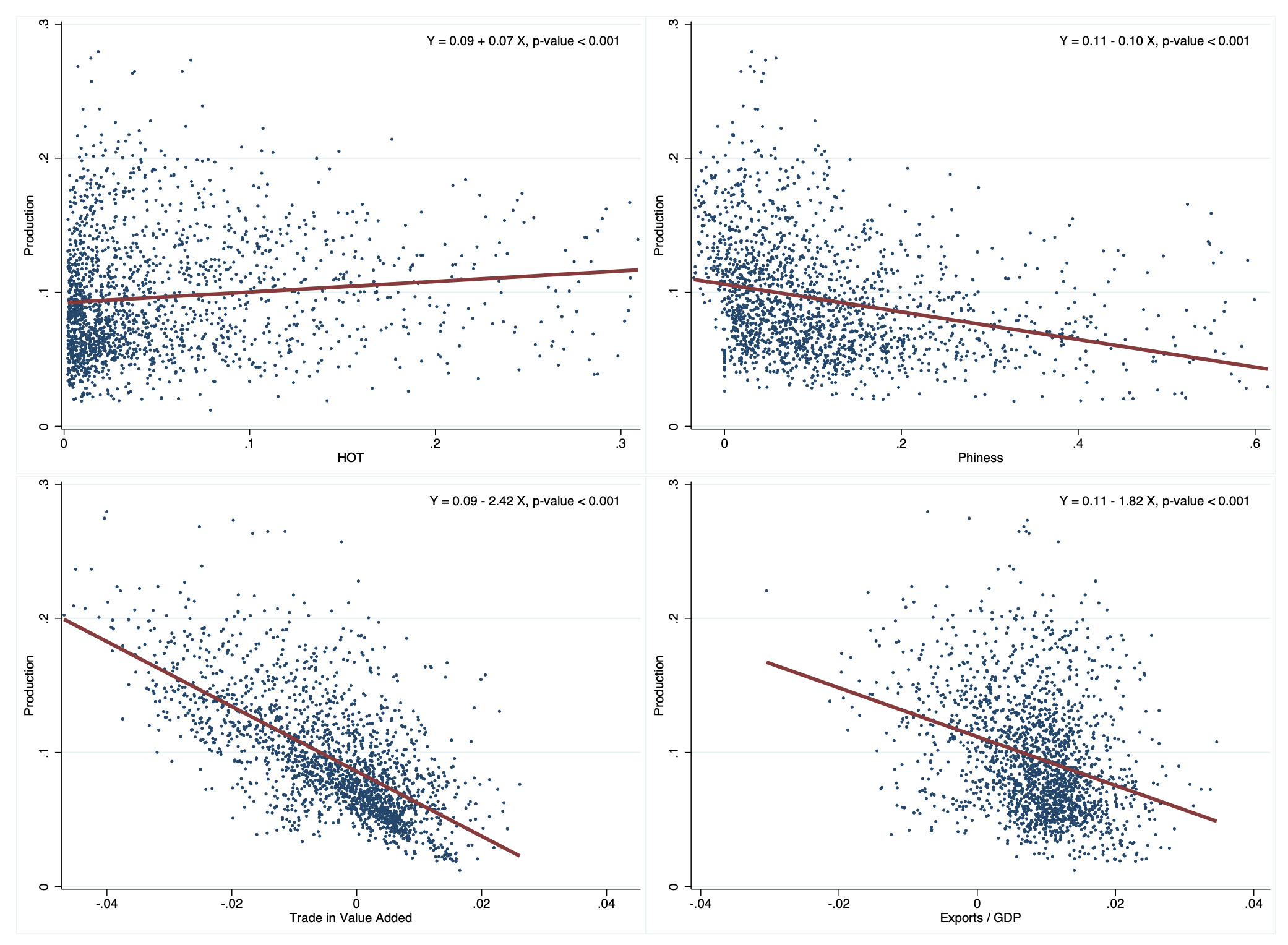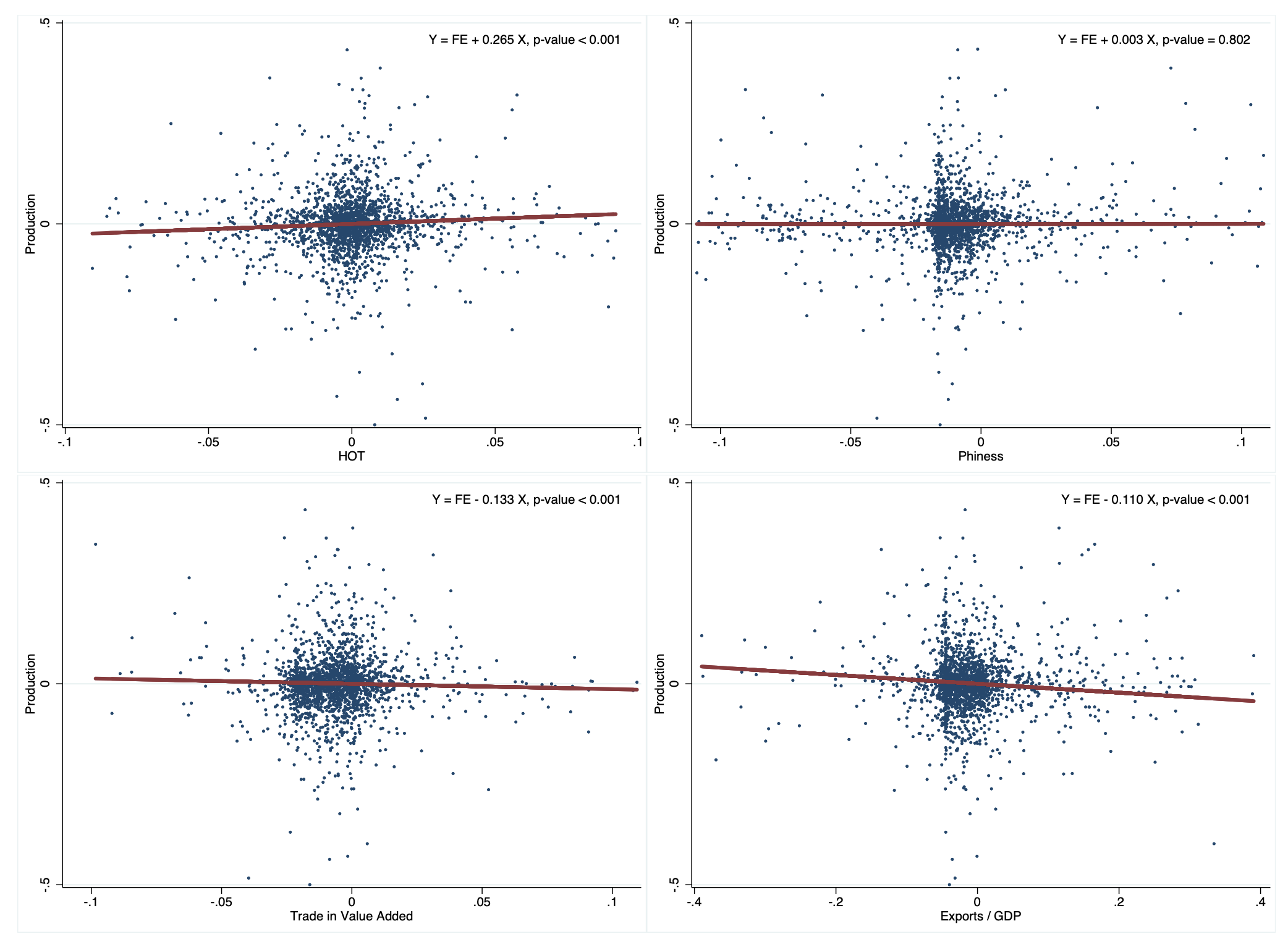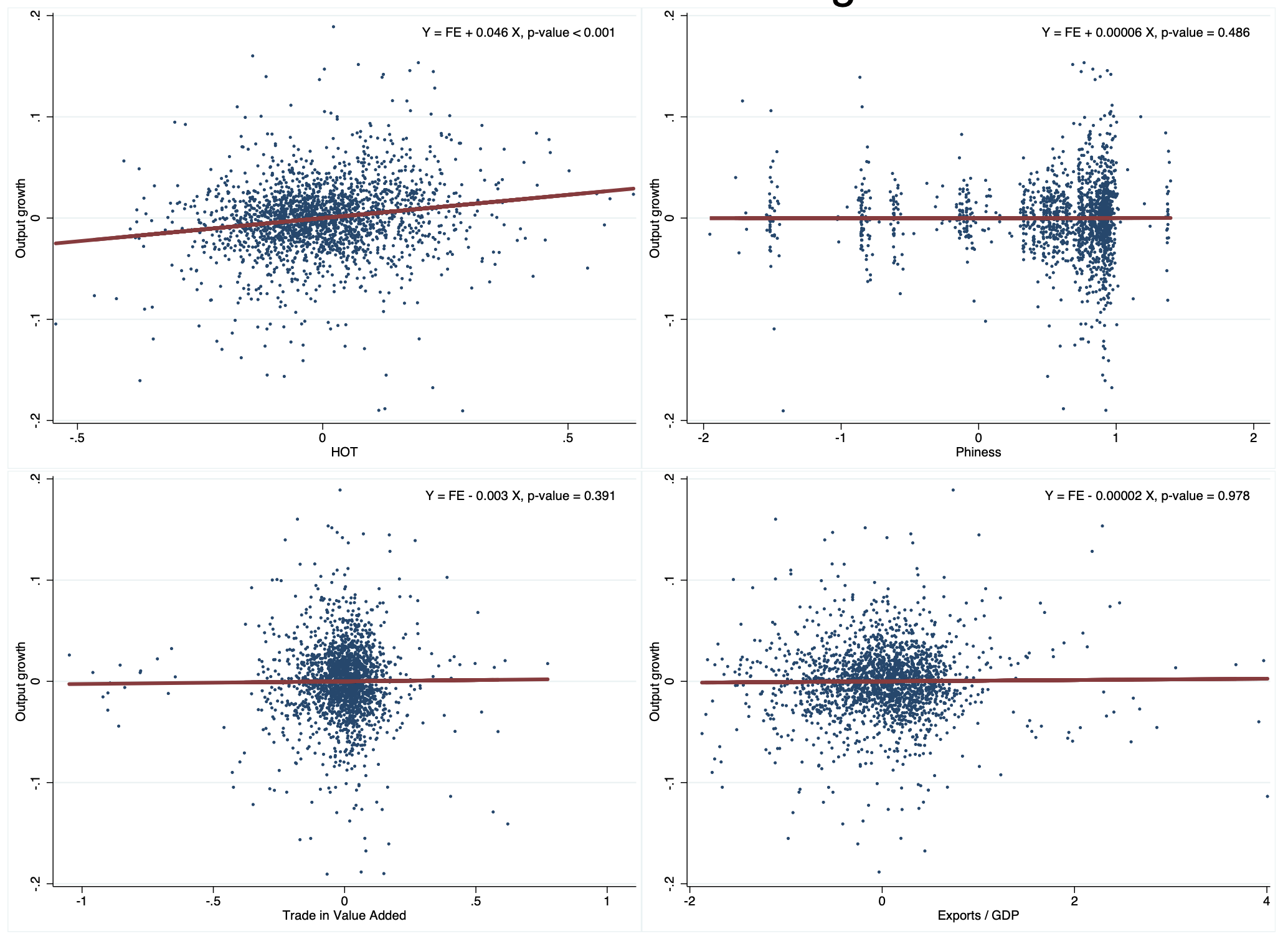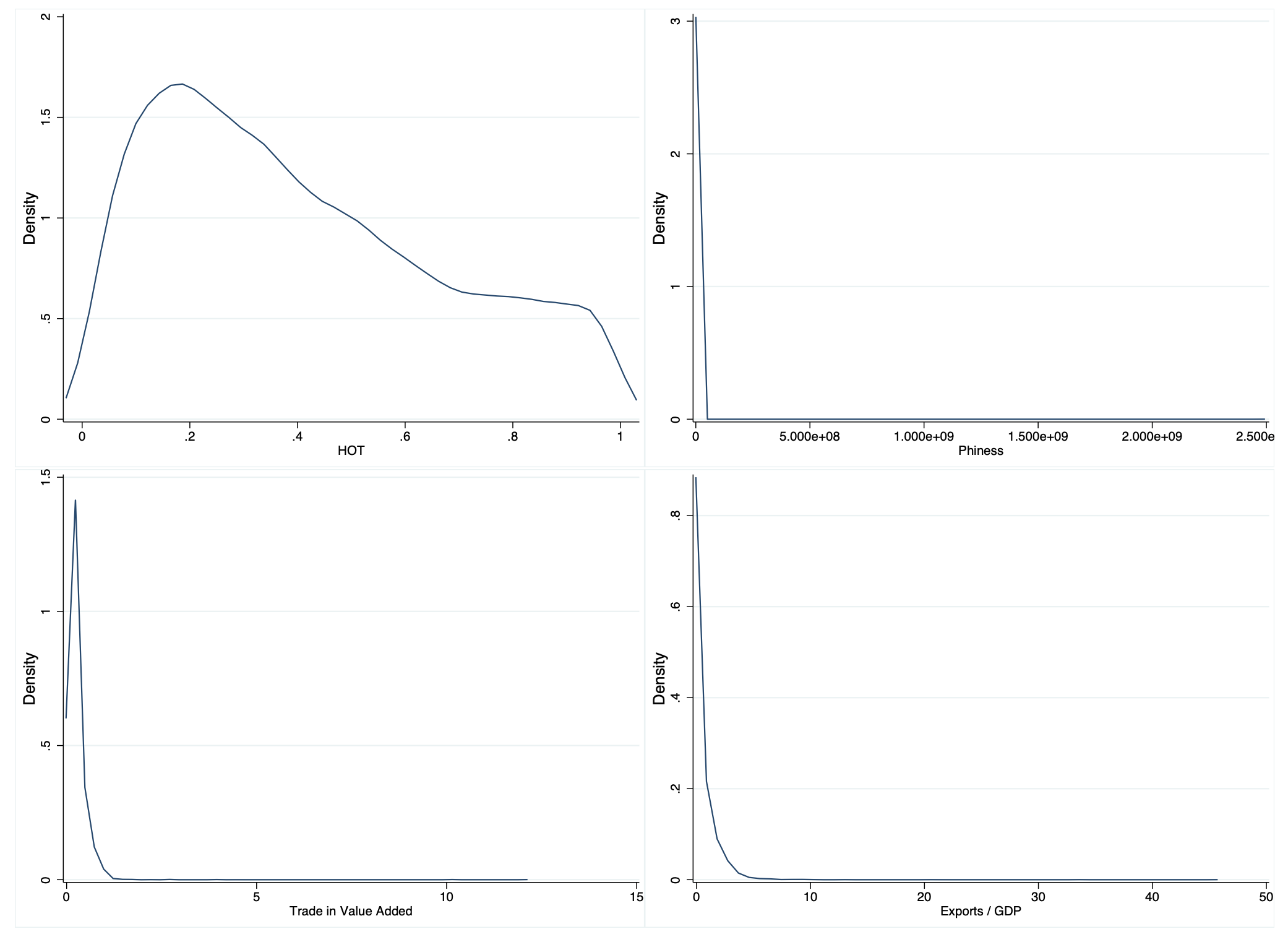The past few years have brought the process of globalization under great strain. The COVID-19 pandemic triggered conversations about the in-shoring of strategic sectors that had not been seen since the 1990s. The war in Ukraine is leading to a potentially great upheaval of trade flows, with global ripple effects. Swings in commodity prices and the successive waves of sanctions on Russia have made it particularly pressing to pinpoint with precision the geographic and sectorial consequences of such sudden changes in foreign conditions. Unsurprisingly there are many available measures of openness at the aggregate or sector level.
But their theoretical ability to capture the consequences of foreign shocks on domestic outcomes accurately remains speculative, especially in a world of global value chains (GVC).
To choose how best to measure the exposure to foreign shocks, we need a model of global value chains. The model can be used to simulate the response of sector-level production across countries to a foreign shock, which can then be compared with the simulated responses of various openness measures to the same shock. The best measure is the one that replicates most accurately the simulated response of production in the model. This is the exercise we perform in Imbs and Pauwels (2022), using an off-the-shelf multi-country multi-sector model with rich linkages and flexible parametrisation, due to Huo et al. (2021).
We simulate four measures of openness: (1) the percentage of value-added that is directly exported, following Alcalá and Ciccone (2004); (2) the trade costs implied by observed bilateral trade flows, sometimes called the ‘phiness’ of trade (Baldwin et al. 2003); (3) the value-added content of trade flows, also known as trade in value-added (TiVA) (Johnson and Noguera 2012); and (4) the fraction of (nominal) output that is sold abroad directly or indirectly via the GVC, which we label ‘HOT’ (Imbs and Pauwels 2020). Global value chains are calibrated from the World Input-Output Database, which reports trade in intermediate goods for 50 sectors in 43 countries. For all sectors in all countries, we collect the 2,000+ responses of all four measures to a foreign shock, calibrated as a US aggregate supply shock. Figure 1 presents scatterplots of these responses against the simulated effect of foreign shocks on domestic production. It is evident that HOT captures best the consequences of foreign shocks on domestic production: the correlation is positive and significant, whereas it is either zero or negative for the three other openness measures.
Figure 1
Note: Simulated responses of value-added and of openness to a US shock
The intuition is straightforward. With high enough substitutability, nominal output increases in response to supply shocks, and thus in response to foreign supply shocks too. Since HOT captures the fraction of output that is sold abroad, it also increases mechanically in response to a foreign supply shock. At the same time, with high enough substitutability, the response of production to a foreign shock is close to that of nominal output since the response of prices is muted. It follows then that HOT correlates systematically with production in response to foreign supply shocks. Figure 1 shows this to be true for high elasticities of substitution in final and intermediate goods. In our paper, we show the result continues to hold, albeit weaklier, for lower elasticities.
There is no reason to expect any of the other conventional openness measures to display the same systematic correlation with the response of production to foreign shocks. The fraction of value added that is directly exported does increase with foreign shocks, but only with the shocks that happen in the destination of those exports. Foreign supply shocks that happen further down the value chain have no consequence on this measure, even though in reality they do affect domestic production. The same is true for the phiness of trade since it is also based on direct trade measures. Trade in value-added, on the other hand, focuses on the structure and depth of the GVC, but it is not nominal output that it decomposes – it is trade. Therefore, it does not capture the response of production to shocks.
In theory, therefore, HOT has a special place among measures of openness. We show it does in the data as well. Figure 2 presents scatterplots between the average values of all four measures of openness as against average production for 50 sectors in 43 countries.
Figure 2
Note: Sector-level value added against openness, controlling for country-sector and year means
Figure 3 presents scatterplots between the same four openness measures and the output growth. Both figures indicate positive correlations with HOT, but not with any of the other measures.
Figure 3
Notes: Sector-level growth against openness, controlling for country and sector means.
These results have potentially important ramifications. Firstly, exposure to foreign shocks is substantially more widespread than commonly thought. The conventional view is that open sectors are the exception: openness traditionally concerns only a few activities located in an open country (e.g. manufacturing in China), while most other sectors are closed (e.g. services). As an illustration, Figure 4 reports estimated densities for all four openness measures.
Figure 4
Notes: Density estimates for the four measures of openness.
Exports as a share of production, TiVA, and the phiness of trade all display very skewed distribution, with the vast majority of observations at low levels and a long right-tail: According to any of these measures, most sectors are in fact immune from foreign shocks. The distribution of HOT is much more symmetric, and while the mode is relatively low, around 20%, there are many sectors where more than half of production is sold abroad, directly or indirectly. In other words, most sectors are in fact heavily exposed to foreign shocks. In Imbs and Pauwels (2022), we show these include many services traditionally deemed non-traded because they are barely traded directly.
Secondly and consequently, foreign developments have much more universal effects than hitherto believed. Our preferred measure, HOT, suggests that even seemingly insulated activities stand to be affected by foreign developments. In times of global turmoil, this should be prominent in the minds of policymakers.
References
Alcalá, F and A Ciccone (2004), “Trade and Productivity”, The Quarterly Journal of Economics 119(2):613–646.
Baldwin, R, R Forslid, P Martin and F Robert-Nicoud (2003), “The core-periphery model: Key features and effects”, in The Monopolistic Competition Revolution in Retrospect: 213–235, Cambridge University Press.
Bems, R and A K Kikkawa (2019), “Measuring trade in value added with Firm-Level Data”, National Bank of Belgium Working Paper Research 378.
Frankel, J A and D H Romer (1999), “Does Trade Cause Growth?”, American Economic Review 89(3): 379-399.
Head, K and T Mayer (2004), “The empirics of agglomeration and trade”, In Handbook of Regional and Urban Economics, chapter 59, North-Holland.
Imbs, J and L Pauwels (2020), “High Order Openness”, CEPR Discussion Papers 14653.
Imbs, J and L Pauwels (2022), “Measuring Openness”, CEPR Discussion Papers 17230.
Johnson, R C (2014), “Trade in intermediate inputs and business cycle comovement”, American Economic Journal: Macroeconomics 6(4): 39-83.
Johnson, R C and G Noguera (2012), “Accounting for intermediates: Production sharing and trade in value added”, Journal of International Economics 86(2): 224–236.







